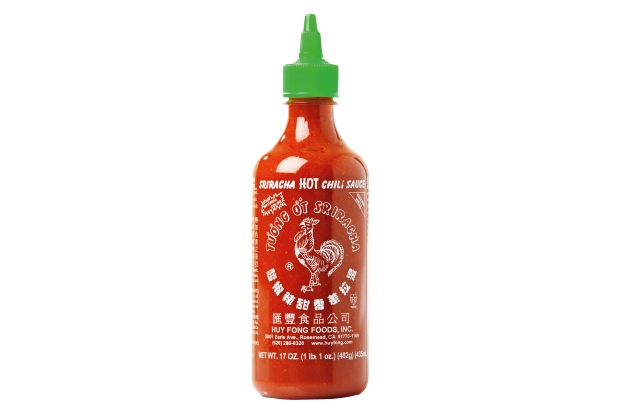Sriracha, for the uninitiated, is a chilli sauce, thicker and sweeter than Tabasco, with a garlicky tang. They eat it in Thailand and Vietnam, though the world’s top brand is made in California with a distinctive rooster on the bottle. Once you have Sriracha in the fridge, you find yourself adding it to many ad hoc meals: fried eggs, falafel, corn fritters. It’s ketchup for grown-ups: a comforting dab of something sweet and spicy that makes everything taste familiar.
I’m fond enough of Sriracha, as mass-market condiments go. But mere fondness does not cut it in this age of social media. Sriracha is one of many foods — see also pulled pork, avocado toast, popcorn, kale, and custard doughnuts — that are now the objects of lunatic devotion on Twitter. It has become a fetish and a cult. Worshippers say it makes ‘everything’ taste better or that they’d like to be buried with a bottle when they die. In December, it was announced that Sriracha powder was coming to the UK. Twitter was abuzz, imagining all the things that could be doused in this magical red dust. No one seemed to notice that chilli powder has been around for centuries or that what makes Sriracha good is that it is a sauce.
Sriracha exemplifies the problem with food on social media in general. These new global forms of communication should be widening our culinary horizons. Often, however, they only reinforce us in our limited tastes through a kind of faddish group hysteria. Spiralised courgettes or grain bowls will briefly ‘trend’ and then suffer a vicious backlash. Food becomes polarised into the indulgent and the ‘clean’. There is group-salivation over fried chicken and you feel bullied to take a stand on such pressing matters as paleo diets or cupcakes versus macarons. Do you like or unlike ‘bone broth’? Or perhaps you are naive enough to think that ‘bone broth’ is simply a pretentious way to describe stock? In that case, Twitter is no place for you.
It’s not that social media has no culinary benefits; particularly if those you live with have a limited appetite for food-talk. In the online stock exchange of kitchen knowledge, you can find exactly the person you need to answer your pressure-cooker query (that would be @catlilycooks, by the way). You can hold long uncensored conversations about the best ways to snap asparagus without anyone telling you how boring you are being. The Oxford Symposium on Food and Cookery, of which I am chair, has a Facebook page with more than 4,000 members and an extraordinary range of debates. Here, scholars discuss such questions as the shortcomings of the word ‘foodie’ or the difficulties of buying certain types of offal.
Cooking can be a repetitive and solitary business and it can be nice to feel less alone at the chopping board: to observe on Twitter that someone else made watercress soup too or to borrow a chef’s idea for pairing damsons with hazelnuts. The danger is that you spend so long obsessing over other people’s dinners that you have little time left to cook your own.
Social media has changed the basic ways that many people relate to food. Most ‘shares’ are really boasts, dressed up with Instagram filters. Spend too long staring at these photogenic creations and you start to judge meals more on looks than taste. We find ourselves randomly scattering pomegranate seeds because they make almost any dish look photo-ready. We spend so long ‘curating’ our breakfast of chia-seed porridge with half-moon slices of plums that it goes cold. We probably do not share the private broken biscuit, or the burnt crumpet, but we most certainly broadcast the fact that we ordered the beauteous meze selection at Honey & Co. (I am guilty of this myself.)
I don’t agree with those who say that food in restaurants should never be photographed. Sometimes a dish is as splendid as a still life and deserves to be recorded. But the indiscriminate tweeting of food erodes both the conviviality and the sensory enjoyment of eating. Overuse of social media kills the thing it is trying to capture: the pleasure of the meal. Sometimes, long ago in the 1990s, people used to pause for a moment when food arrived at the table, to inhale the happy scents of garlic and parsley or talk about who ordered best. Now, this moment is taken up with a frantic bustle of iPhones. The ‘feed’ takes precedence over the food. The vital task is no longer to eat what’s on your plate, but to snap it while it is still pristine, in the hope that it may be favourited, retweeted and liked. So anxious are we to make our food popular that we forget the basic niceties of sharing a meal with the people who are actually with us. Clue: it’s friendly to make eye contact from time to time.
There is a form of denial going on here. If we memorialise enough of our meals on electronic devices, we can plaster over the truth that to eat food, you must destroy it. Once consumed, it is gone. Most dishes — homely stews, say, that do not have pomegranate seeds on top — go unrecorded; the only traces are in our bodies. The full plate must give way to the empty plate and each set of washing-up takes us another step closer to the end. It’s a terrifying thought. No wonder we feel the need to distract ourselves by babbling cheerful nonsense about Sriracha.






Comments